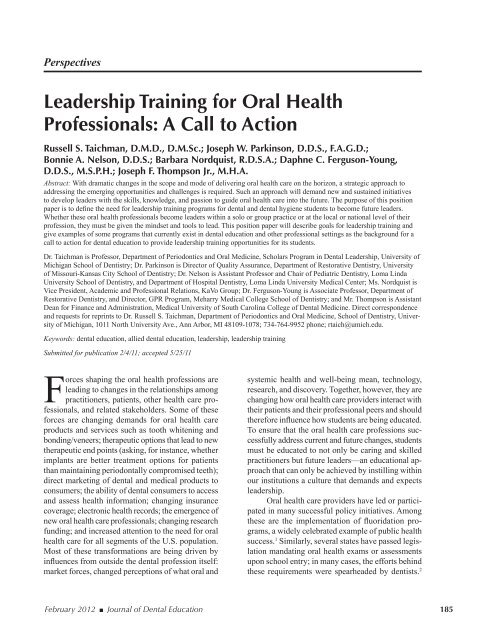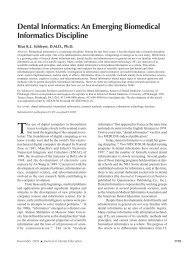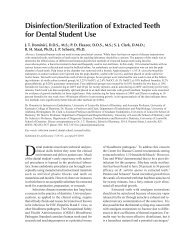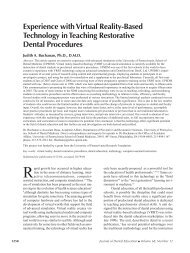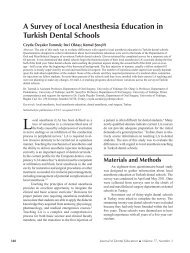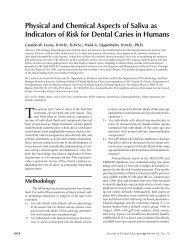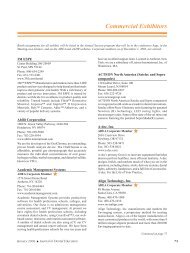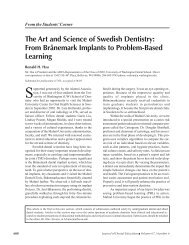Leadership Training for Oral Health Professionals: A Call to Action
Leadership Training for Oral Health Professionals: A Call to Action
Leadership Training for Oral Health Professionals: A Call to Action
You also want an ePaper? Increase the reach of your titles
YUMPU automatically turns print PDFs into web optimized ePapers that Google loves.
Perspectives<br />
<strong>Leadership</strong> <strong>Training</strong> <strong>for</strong> <strong>Oral</strong> <strong>Health</strong><br />
<strong>Professionals</strong>: A <strong>Call</strong> <strong>to</strong> <strong>Action</strong><br />
Russell S. Taichman, D.M.D., D.M.Sc.; Joseph W. Parkinson, D.D.S., F.A.G.D.;<br />
Bonnie A. Nelson, D.D.S.; Barbara Nordquist, R.D.S.A.; Daphne C. Ferguson-Young,<br />
D.D.S., M.S.P.H.; Joseph F. Thompson Jr., M.H.A.<br />
Abstract: With dramatic changes in the scope and mode of delivering oral health care on the horizon, a strategic approach <strong>to</strong><br />
addressing the emerging opportunities and challenges is required. Such an approach will demand new and sustained initiatives<br />
<strong>to</strong> develop leaders with the skills, knowledge, and passion <strong>to</strong> guide oral health care in<strong>to</strong> the future. The purpose of this position<br />
paper is <strong>to</strong> define the need <strong>for</strong> leadership training programs <strong>for</strong> dental and dental hygiene students <strong>to</strong> become future leaders.<br />
Whether these oral health professionals become leaders within a solo or group practice or at the local or national level of their<br />
profession, they must be given the mindset and <strong>to</strong>ols <strong>to</strong> lead. This position paper will describe goals <strong>for</strong> leadership training and<br />
give examples of some programs that currently exist in dental education and other professional settings as the background <strong>for</strong> a<br />
call <strong>to</strong> action <strong>for</strong> dental education <strong>to</strong> provide leadership training opportunities <strong>for</strong> its students.<br />
Dr. Taichman is Professor, Department of Periodontics and <strong>Oral</strong> Medicine, Scholars Program in Dental <strong>Leadership</strong>, University of<br />
Michigan School of Dentistry; Dr. Parkinson is Direc<strong>to</strong>r of Quality Assurance, Department of Res<strong>to</strong>rative Dentistry, University<br />
of Missouri-Kansas City School of Dentistry; Dr. Nelson is Assistant Professor and Chair of Pediatric Dentistry, Loma Linda<br />
University School of Dentistry, and Department of Hospital Dentistry, Loma Linda University Medical Center; Ms. Nordquist is<br />
Vice President, Academic and Professional Relations, KaVo Group; Dr. Ferguson-Young is Associate Professor, Department of<br />
Res<strong>to</strong>rative Dentistry, and Direc<strong>to</strong>r, GPR Program, Meharry Medical College School of Dentistry; and Mr. Thompson is Assistant<br />
Dean <strong>for</strong> Finance and Administration, Medical University of South Carolina College of Dental Medicine. Direct correspondence<br />
and requests <strong>for</strong> reprints <strong>to</strong> Dr. Russell S. Taichman, Department of Periodontics and <strong>Oral</strong> Medicine, School of Dentistry, University<br />
of Michigan, 1011 North University Ave., Ann Arbor, MI 48109-1078; 734-764-9952 phone; rtaich@umich.edu.<br />
Keywords: dental education, allied dental education, leadership, leadership training<br />
Submitted <strong>for</strong> publication 2/4/11; accepted 5/25/11<br />
Forces shaping the oral health professions are<br />
leading <strong>to</strong> changes in the relationships among<br />
practitioners, patients, other health care professionals,<br />
and related stakeholders. Some of these<br />
<strong>for</strong>ces are changing demands <strong>for</strong> oral health care<br />
products and services such as <strong>to</strong>oth whitening and<br />
bonding/veneers; therapeutic options that lead <strong>to</strong> new<br />
therapeutic end points (asking, <strong>for</strong> instance, whether<br />
implants are better treatment options <strong>for</strong> patients<br />
than maintaining periodontally compromised teeth);<br />
direct marketing of dental and medical products <strong>to</strong><br />
consumers; the ability of dental consumers <strong>to</strong> access<br />
and assess health in<strong>for</strong>mation; changing insurance<br />
coverage; electronic health records; the emergence of<br />
new oral health care professionals; changing research<br />
funding; and increased attention <strong>to</strong> the need <strong>for</strong> oral<br />
health care <strong>for</strong> all segments of the U.S. population.<br />
Most of these trans<strong>for</strong>mations are being driven by<br />
influences from outside the dental profession itself:<br />
market <strong>for</strong>ces, changed perceptions of what oral and<br />
systemic health and well-being mean, technology,<br />
research, and discovery. Together, however, they are<br />
changing how oral health care providers interact with<br />
their patients and their professional peers and should<br />
there<strong>for</strong>e influence how students are being educated.<br />
To ensure that the oral health care professions successfully<br />
address current and future changes, students<br />
must be educated <strong>to</strong> not only be caring and skilled<br />
practitioners but future leaders—an educational approach<br />
that can only be achieved by instilling within<br />
our institutions a culture that demands and expects<br />
leadership.<br />
<strong>Oral</strong> health care providers have led or participated<br />
in many successful policy initiatives. Among<br />
these are the implementation of fluoridation programs,<br />
a widely celebrated example of public health<br />
success. 1 Similarly, several states have passed legislation<br />
mandating oral health exams or assessments<br />
upon school entry; in many cases, the ef<strong>for</strong>ts behind<br />
these requirements were spearheaded by dentists. 2<br />
February 2012 ■ Journal of Dental Education 185
Other highlights include the development of dental<br />
sealant and prevention programs. 3 Achievement of<br />
these and other successes required broad-based support<br />
networks among coalitions of stakeholders that<br />
provided the leadership, impetus, and environment<br />
<strong>for</strong> change <strong>to</strong> occur.<br />
Yet while there have been great successes, there<br />
have also been challenges. The oral health professions<br />
have generally been unable <strong>to</strong> implement ways<br />
<strong>to</strong> address the basic oral health care needs of a large<br />
number of Americans. The reasons are varied and<br />
extend beyond oral care <strong>to</strong> health care in general,<br />
yet the inability <strong>to</strong> provide solutions <strong>to</strong> the access<br />
problem has left many elected officials feeling they<br />
have little choice but <strong>to</strong> consider solutions outside<br />
of our profession. 4,5<br />
A part of the problem lies in the current mission<br />
focus of U.S. dental schools. We excel in educating<br />
students in the art and science of dentistry by focusing<br />
on knowledge in the basic sciences and the development<br />
of clinical skills. We also acknowledge those<br />
individuals who take on leadership roles within our<br />
profession. What we do not do is make a concerted<br />
ef<strong>for</strong>t <strong>to</strong> enhance those leadership skills that many<br />
students bring <strong>to</strong> their profession. Nor do we have<br />
a systematic approach <strong>to</strong> nurture the development<br />
of leadership skills and a leadership mindset among<br />
dental and dental hygiene students that are essential<br />
<strong>to</strong> move the profession <strong>for</strong>ward. The purpose of this<br />
position paper is <strong>to</strong> define the need <strong>for</strong> leadership<br />
training programs <strong>for</strong> dental and dental hygiene students<br />
<strong>to</strong> become future leaders. Whether these oral<br />
health professionals become leaders within a solo<br />
or group practice or at the local or national level of<br />
their profession, they must be given the mindset and<br />
<strong>to</strong>ols <strong>to</strong> lead. This position paper will describe goals<br />
<strong>for</strong> leadership training and give examples of some<br />
programs that currently exist in dental education and<br />
in other professional settings as the background <strong>for</strong> a<br />
call <strong>to</strong> action <strong>for</strong> dental education <strong>to</strong> provide leadership<br />
training opportunities <strong>for</strong> its students.<br />
Defining <strong>Oral</strong> <strong>Health</strong><br />
<strong>Leadership</strong><br />
Defining the characteristics of leaders has been<br />
going on <strong>for</strong> centuries. Philosophers from Pla<strong>to</strong> on<br />
have pondered what distinguishes leaders from others,<br />
based on the premise that leadership is rooted<br />
in the characteristics possessed by certain individuals.<br />
This trait-based perspective on leadership has<br />
dominated much of the study in the field. A number<br />
of characteristics have been proposed <strong>to</strong> distinguish<br />
leaders from nonleaders: these include intelligence,<br />
dominance, adaptability, persistence, integrity, socioeconomic<br />
status, and self-confidence. 6 An alternative<br />
perspective on what constitutes leaders is based upon<br />
circumstances: that is, the situation itself molds the<br />
leader, so that leaders in one situation may not necessarily<br />
be leaders elsewhere.<br />
What constitutes leadership? Noting “there<br />
is no infallible step-by-step <strong>for</strong>mula <strong>for</strong> becoming<br />
an effective or trans<strong>for</strong>mational leader,” Slavkin<br />
argued that “leadership signifies the act of making<br />
a difference” and that “leadership generally entails<br />
sustaining, improving, or changing strategic directions<br />
within small or large, simple or complex,<br />
organizations.” 7 We would add <strong>to</strong> this definition that<br />
leadership entails the effective communication of<br />
a vision (whether shared or not) and an honest and<br />
in-depth evaluation of collective experiences and/<br />
or available data so that organizational change may<br />
occur in a rational manner.<br />
There are many examples of dentists exhibiting<br />
leadership within the scope of their practices, in<br />
industry, research, and education, and in professional<br />
organizations or governmental bodies. 8 We might<br />
ask what preparation these individuals had <strong>for</strong> the<br />
leadership positions they held. Clearly, reaching a<br />
leadership position and exercising leadership in any<br />
venue result from many steps an individual has taken<br />
as well as circumstances that provided openings.<br />
But the process must start with an individual who is<br />
receptive <strong>to</strong> responsibility and willing <strong>to</strong> take up the<br />
mantle of leadership.<br />
Goals <strong>for</strong> <strong>Leadership</strong><br />
<strong>Training</strong> <strong>for</strong> <strong>Oral</strong> <strong>Health</strong><br />
<strong>Professionals</strong><br />
The dramatic trans<strong>for</strong>mations in the scope<br />
and mode of practice require new and innovative<br />
approaches <strong>to</strong> address these opportunities in how<br />
we as a profession do business. <strong>Oral</strong> health research<br />
and discovery are producing new diagnostic and<br />
therapeutic options <strong>for</strong> our patients. Emerging public<br />
health issues, how we deliver care and access in<strong>for</strong>mation,<br />
emerging ethical dilemmas, faculty shortages,<br />
and changing market <strong>for</strong>ces are likely <strong>to</strong> test<br />
186 Journal of Dental Education ■ Volume 76, Number 2
the profession’s resolve <strong>to</strong> stay current. But within<br />
these trials and challenges there will be opportunities<br />
<strong>to</strong> improve oral health and <strong>to</strong> improve the stature of<br />
the profession by breaking new ground.<br />
Developing leadership skills entails many<br />
facets of life. Dental students are well prepared in<br />
their study of science, diseases, and current technology,<br />
but most dental school curricula lack programs<br />
specifically designed <strong>to</strong> help students learn how <strong>to</strong><br />
navigate a changing environment or how <strong>to</strong> successfully<br />
manage interpersonal relationships, communication,<br />
and decision making skills. Not surprisingly,<br />
students enter dental schools with a variety of skills<br />
that are considered highly desirable by admissions<br />
committees. After graduation, dentists enter practice<br />
and are expected <strong>to</strong> become the leader of the oral<br />
health care team. In fact, the Commission on Dental<br />
Accreditation’s Standard 2-19 reads: “Graduates<br />
must understand the basic principles and philosophies<br />
of practice management and have the skills <strong>to</strong><br />
function successfully as the leader of the oral health<br />
care team.” 9<br />
At the practice level, if a dentist/leader is unable<br />
<strong>to</strong> positively motivate and share a central vision, the<br />
staff’s inability <strong>to</strong> work as a team can cost thousands<br />
of dollars each year in lost production and profit.<br />
Moreover, the financial loss does not even begin<br />
<strong>to</strong> address the cost that failure of leadership means<br />
<strong>to</strong> patients and <strong>to</strong> society, which invests heavily in<br />
the training of dental professionals and depends on<br />
dentists <strong>to</strong> serve as effective advocates <strong>for</strong> the oral<br />
health needs of our nation. Many case studies have<br />
demonstrated that leadership is the missing ingredient<br />
in most failing businesses, and dentistry is not alone. 10<br />
High degrees of staff-related stress and turnover may<br />
be the result of a dentist’s lack of training in basic<br />
leadership and communication skills. A study at<br />
the University of Alabama found that dentists who<br />
engage in participative decision making processes<br />
with staff members create an environment that encourages<br />
collaboration, leading <strong>to</strong> healthy <strong>for</strong>ms of<br />
conflict management and increased productivity. 11<br />
The ability of a dentist <strong>to</strong> be an effective leader who<br />
can recruit and retain excellent employees creates an<br />
environment that carries over <strong>to</strong> high-quality patient<br />
care and services. Satisfied patients also look <strong>to</strong> their<br />
dentists <strong>to</strong> serve as role models and men<strong>to</strong>rs.<br />
Dentists also have opportunities <strong>to</strong> serve as<br />
leaders or change agents within their communities<br />
and neighborhoods. Numerous opportunities exist<br />
in which oral health professionals can lend their<br />
knowledge and support <strong>to</strong> local ef<strong>for</strong>ts that improve<br />
health and well-being. For example, water fluoridation<br />
and sealant programs are often of great benefit<br />
<strong>to</strong> communities as dental caries remains one of the<br />
most prevalent health care issues. Dentists serving<br />
at the local level may also function in important<br />
capacities by helping <strong>to</strong> improve the overall health<br />
of the population as evidence mounts indicating a<br />
possible link between poor oral health and other systemic<br />
conditions. 12-15 In these two areas, dentists may<br />
serve large population segments that are underserved,<br />
particularly in urban and rural areas, by medical and<br />
dental/oral health professionals. Dentists can help<br />
by participating in oral health care education and<br />
outreach programs.<br />
Within dental school/oral health curricula,<br />
training future leaders of the profession has generally<br />
been relegated <strong>to</strong> the training of academic and<br />
scientific leaders. A long his<strong>to</strong>ry of programs, events,<br />
and support mechanisms are available <strong>to</strong> guide/men<strong>to</strong>r<br />
aspiring oral health leaders in<strong>to</strong> the critical roles<br />
of academic dentistry. While much has been written<br />
<strong>to</strong> address faculty shortages, at least there are established<br />
venues and role models that can facilitate the<br />
recruitment and retention of these valuable members<br />
of our profession in these roles. Yet beyond these<br />
venues and targeted leadership positions there are<br />
few opportunities.<br />
Table 1 presents our vision of some characteristics<br />
of an ideal leadership training program <strong>for</strong><br />
oral health care professionals. <strong>Leadership</strong> training<br />
programs specifically designed <strong>to</strong> foster studentfaculty<br />
dialogue focused on leadership development<br />
are starting <strong>to</strong> emerge. In many ways, these programs<br />
provide in<strong>for</strong>mal settings <strong>for</strong> collegial discussions<br />
that would not normally occur within a classroom or<br />
clinical setting. In this respect, it is envisioned that<br />
many of the institutional barriers <strong>to</strong> learning can be<br />
Table 1. Characteristics of an ideal training program in<br />
leadership <strong>for</strong> oral health professionals<br />
• Focuses development on areas of strength and<br />
interest rather than building competence in weak<br />
areas exclusively.<br />
• Focuses on active adult learning.<br />
• Reflects institution’s long-term commitment <strong>to</strong><br />
build leadership capacity in alumni.<br />
• Serves as an opportunity <strong>to</strong> bring <strong>to</strong>gether resources<br />
and individuals who have not traditionally<br />
participated in oral health education (e.g., business<br />
leaders outside of dentistry, motivational speakers,<br />
journalists).<br />
February 2012 ■ Journal of Dental Education 187
overcome. Moreover, focus on leadership as a venue<br />
<strong>for</strong> scholarship at both local and national levels is<br />
possible and may ultimately provide a vehicle <strong>for</strong><br />
addressing faculty shortages. 16,17 Since most dental<br />
school applicants are not specifically targeted and recruited<br />
in<strong>to</strong> the profession <strong>for</strong> their desire <strong>to</strong> become<br />
faculty members or leaders, enhanced exposure <strong>to</strong><br />
faculty and adjunctive faculty members in leadership<br />
roles is bound <strong>to</strong> create a climate that sends a very<br />
different message <strong>to</strong> students. We believe that this<br />
exposure may stimulate participants <strong>to</strong> seek career<br />
paths they may not have otherwise considered.<br />
<strong>Leadership</strong> <strong>Training</strong> in<br />
Other Professional Schools<br />
As in dentistry, leadership training in medical<br />
education would be desirable in many facets of<br />
physicians’ career as they interact with patients and<br />
the many facets of the health care industry. In the<br />
article “<strong>Leadership</strong>: ‘They Never Taught Me This in<br />
Medical School,’” Fruge et al. outline a leadership<br />
curriculum <strong>for</strong> fellows at the Texas Children’s Hospital.<br />
18 The approach presented is case-based in seminar<br />
style. O’Connell and Pascoe evaluated eight schools<br />
incorporating medical education <strong>for</strong> the twenty-first<br />
century content: leadership and teamwork. They<br />
believed that leadership training worked well if<br />
incorporated in<strong>to</strong> clinical activities where the skills<br />
could be used. 19 A learning community is another way<br />
<strong>to</strong> integrate leadership in<strong>to</strong> medical education; when<br />
the students get involved in this system, learning is<br />
done by both the students and other members of the<br />
learning community including faculty members and<br />
other stakeholders. 20,21 The most common stated goals<br />
of these organizations are <strong>to</strong> improve communication<br />
and teamwork, establish academic support networks,<br />
and promote leadership development.<br />
Yet other models exist. As in the education of<br />
other professionals, there are many programs that<br />
students can be involved in <strong>to</strong> learn better leadership<br />
skills 22,23 and many articles that address the needs and<br />
programs <strong>for</strong> medical education and medical resident<br />
education. 24,25<br />
Like medicine and dentistry, as business school<br />
graduates enter the work<strong>for</strong>ce, leadership training<br />
in the corporate world is often tailored <strong>to</strong> suit niche<br />
needs. These needs often represent the distinctive<br />
management and leadership approach of the organization.<br />
One large organization with a highly evolved<br />
leadership program regularly updates this program <strong>to</strong><br />
remain current and relevant. As with most corporations<br />
that have professional development programs,<br />
most include some elements relating <strong>to</strong> promoting and<br />
nurturing leaders. Often companies, especially smaller<br />
companies, use outside-developed, more generic programs<br />
that were not necessarily tailored <strong>to</strong> represent<br />
the culture and ethos of the specific company.<br />
Business schools are often seen as leaders in<br />
general management skills and in leadership. Bennis’s<br />
pioneering work laid the groundwork <strong>for</strong> many<br />
of the modern re<strong>for</strong>ms in business education. 26 His<br />
approach includes recognition of the role of judgment<br />
and emotion in decision making and the importance<br />
of ethics. Still, many business schools <strong>to</strong>day have<br />
been criticized <strong>for</strong> not teaching effective leadership,<br />
so a new approach is required focusing research on<br />
phenomena and problems of enduring importance<br />
and building curricula that are evaluated, in part, by<br />
how well they actually prepare students <strong>to</strong> be effective<br />
in practicing the profession.<br />
Increasingly, corporations are developing their<br />
own future generations of leaders through internally<br />
developed educational programs. These programs<br />
seek <strong>to</strong> capitalize on their own successful leadership<br />
and results in order <strong>to</strong> drive these skills further down<br />
the management team. Many of these programs have<br />
a structured curriculum covering the many management<br />
disciplines, taught by managers from across the<br />
corporation. These programs often rely on reviewing<br />
and learning from the successes of the company in<br />
order <strong>to</strong> teach desired actions and behavior. Thus, the<br />
next generations of leaders are nurtured within the<br />
framework of a successful corporation.<br />
Examples of <strong>Leadership</strong><br />
<strong>Training</strong> <strong>for</strong> Dental and<br />
Dental Hygiene Students<br />
What should leadership training in dentistry<br />
be in the context of a need <strong>for</strong> oral health leaders?<br />
Is the best practice <strong>for</strong> dentistry <strong>to</strong> look <strong>to</strong> business<br />
schools or other professional programs <strong>for</strong> leadership<br />
content? Is management training leadership training?<br />
Should the focus be on leading a dental practice<br />
or training dentists/dental hygienists <strong>to</strong> be leaders<br />
at local, state, and national levels? Is a research<br />
experience leadership training in and of itself? We<br />
assert that the need is much greater and goes beyond<br />
188 Journal of Dental Education ■ Volume 76, Number 2
existing practices. Dental schools must develop their<br />
own curricula.<br />
As leadership training is becoming more prevalent<br />
in other industries, there is vast divergence in<br />
the perceived need or scope. As such, the state of<br />
the art <strong>for</strong> dentistry developed specifically <strong>to</strong> address<br />
the needs of dentists is still in its infancy. How have<br />
leadership training programs been incorporated and<br />
conceived within dental school communities? Vic<strong>to</strong>roff<br />
et al. found that dental students overwhelmingly<br />
view leadership as a part of their profession and<br />
would be willing <strong>to</strong> participate in leadership training<br />
programs if they existed within their institutions. 8,27<br />
Interestingly, in 2000 nearly 70 percent of responding<br />
dental school deans reported that leadership training<br />
was the most crucial aspect in preparing <strong>to</strong> become a<br />
dean. 28 In fact, this area of study and experience was<br />
perceived by the respondents <strong>to</strong> be more important<br />
than the ability <strong>to</strong> teach dentistry, knowledge of budget<br />
and finance, and conducting research.<br />
The concept that leadership instruction in dental<br />
schools needs <strong>to</strong> be developed <strong>for</strong> dentistry is a<br />
critical departure from how many industries provide<br />
leadership training. An eleven-week program was<br />
recently reported at the School of Dentistry at the<br />
University of Southern Cali<strong>for</strong>nia. 29 This program<br />
combines much of the traditional industry-wide<br />
aspects of leadership training including communication<br />
styles and listening, people management, creating<br />
and leading a team, building coalitions, conflict<br />
management, and fiscal management. Kalenderian et<br />
al. reported on the recent development of a third-year<br />
course titled “Dental <strong>Health</strong> Care Delivery: Concepts<br />
of <strong>Oral</strong> <strong>Health</strong> <strong>Leadership</strong>” at Harvard School of<br />
Dental Medicine. 30 The course focused on management<br />
and leadership concepts. The management <strong>to</strong>pics<br />
focused on practice management, patient-centered<br />
care, public health dentistry, and systems analysis<br />
of medical errors, including how <strong>to</strong> improve patient<br />
safety. The leadership <strong>to</strong>pics included ethics, systemic<br />
intervention <strong>to</strong> reduce oral health disparities,<br />
cultural awareness, building a team environment,<br />
interpersonal communication skills, and conflict<br />
management. The course met weekly <strong>for</strong> a <strong>to</strong>tal of<br />
fifty-four hours over twenty-two weeks, with the time<br />
split evenly between management and leadership.<br />
At the University of Michigan, a Scholars<br />
Program in Dental <strong>Leadership</strong> (SPDL) has been<br />
developed that encompasses all four years of the<br />
dental curriculum <strong>to</strong> provide sufficient time <strong>for</strong><br />
group learning and the development of caps<strong>to</strong>ne<br />
projects targeting the interests of the participants<br />
themselves. 31 The SPDL was designed <strong>to</strong> wrap around<br />
the curriculum so that program events would occur<br />
mainly after hours. Program enrollment is based upon<br />
an application process that requires applicants <strong>to</strong> seek<br />
out partnering men<strong>to</strong>rs. Program activities include<br />
yearly kick-off events, student-held organizational<br />
and progress meetings focused on project/caps<strong>to</strong>ne<br />
development, and monthly leadership training events<br />
in which guest speakers are asked <strong>to</strong> participate. Currently,<br />
this after-school program is serving as part of a<br />
curriculum design launched in fall 2010 in which all<br />
dental students have time designated across all four<br />
years <strong>for</strong> one of three pathways: health care delivery,<br />
research, or leadership. Students in the leadership<br />
pathway focus on critical issues <strong>for</strong> the profession,<br />
participate in a leadership journal club, and develop<br />
projects that hone their leadership skills in addition<br />
<strong>to</strong> content provided in the SPDL program.<br />
Several questions must be answered in order <strong>for</strong><br />
schools <strong>to</strong> implement leadership training programs.<br />
First, do students value the development of leadership<br />
skills, and will they participate? Vic<strong>to</strong>roff et al. found<br />
that dental students view leadership as a part of their<br />
profession and would participate in leadership training<br />
programs within their institutions. 8 Second, how<br />
would such a program fit within an already packed<br />
curriculum? That is, should leadership training be a<br />
distinct course, or should content be embedded within<br />
existing courses or as an extracurricular activity?<br />
Third, what would this curricular supplement cost,<br />
and how would those expenses be managed? Finally,<br />
who will provide the content? Are existing faculty<br />
members capable of providing leadership training,<br />
or would it be best <strong>to</strong> partner with other programs?<br />
These aspects of program design are discussed in an<br />
accompanying article. 32<br />
Conclusions<br />
Stand-alone leadership training <strong>for</strong> dental and<br />
allied dental students is a new educational opportunity<br />
that is currently unexplored in most institutions,<br />
yet many aspects of the current curriculum could be<br />
used or expanded upon as a basis <strong>for</strong> leadership training.<br />
These include practice management, diversity<br />
education, and research training.<br />
We believe that a focus on leadership studies<br />
would change the culture of our profession in a positive<br />
direction. Stating that we as a profession value<br />
February 2012 ■ Journal of Dental Education 189
leadership and providing opportunities <strong>for</strong> students<br />
<strong>to</strong> exercise new skills would enrich education <strong>for</strong><br />
students and faculty members alike. By focusing on<br />
challenging group or individual projects, we believe<br />
that new alliances from across campuses and professions<br />
will be <strong>for</strong>ged. The benefits of these cannot be<br />
completely envisioned at this point. It would be a<br />
mistake <strong>for</strong> most of us <strong>to</strong> look <strong>to</strong> other professionals,<br />
be it business or medicine, <strong>to</strong> provide content. However,<br />
our culture and our students will benefit from<br />
these experiments with new and exciting educational<br />
opportunities. The important point is <strong>to</strong> start a discussion<br />
focused on leadership. Different individuals<br />
and schools will have different definitions, outcome<br />
measures, and methods <strong>to</strong> achieve leadership competencies,<br />
yet it is through discussion that we will<br />
change our profession.<br />
Acknowledgments<br />
The authors would like <strong>to</strong> thank their parent<br />
institutions and deans <strong>for</strong> support during their participation<br />
in the American Dental Education Association<br />
(ADEA) <strong>Leadership</strong> Institute. The authors would<br />
like <strong>to</strong> acknowledge the help of Dr. Cecile Feldman,<br />
dean, University of Medicine & Dentistry/New<br />
Jersey Dental School; Dr. Karl Haden, president,<br />
Academy <strong>for</strong> Academic <strong>Leadership</strong>, and his staff; and<br />
other fellows in the ADEA <strong>Leadership</strong> Institute. Dr.<br />
Taichman is supported by grants from the National<br />
Institutes of <strong>Health</strong> (DK082481, RC1DE020721,<br />
AR056893, CA093900) and the Department of Defense<br />
(PC073952). Sincere appreciation also goes <strong>to</strong><br />
ADEA and Alpha Omega Foundation <strong>for</strong> supporting<br />
Dr. Taichman as a Leonard Abrams Scholar during<br />
his participation in the ADEA <strong>Leadership</strong> Institute.<br />
Finally, we would like <strong>to</strong> acknowledge the support<br />
and encouragement of our families and our students,<br />
<strong>for</strong> whom this work is intended.<br />
REFERENCES<br />
1. Easley MW. Celebrating 50 years of fluoridation: a public<br />
health success s<strong>to</strong>ry. Br Dent J 1995;178:72–5.<br />
2. Policy on manda<strong>to</strong>ry school-entrance oral health examinations.<br />
Pediatr Dent 2008;30:26–7.<br />
3. Buonocore MG. Caries prevention in pits and fissures<br />
sealed with an adhesive resin polymerized by ultraviolet<br />
light: a two-year study of a single adhesive application. J<br />
Am Dent Assoc 1971;82:1090–3.<br />
4. Hathaway KL. An introduction <strong>to</strong> oral health care re<strong>for</strong>m.<br />
Dent Clin North Am 2009;53:561–72.<br />
5. Harris T. The U.S. oral health work<strong>for</strong>ce in the coming<br />
decade: workshop summary. Washing<strong>to</strong>n, DC: Institute<br />
of Medicine, 2009.<br />
6. Bass B, Bass R. The Bass handbook of leadership: theory,<br />
research, and managerial applications. 4th ed. New York:<br />
Free Press, 2008.<br />
7. Slavkin H. <strong>Leadership</strong> <strong>for</strong> health care in the 21st century:<br />
a personal perspective. J <strong>Health</strong>care <strong>Leadership</strong><br />
2010;2:35–41.<br />
8. Vic<strong>to</strong>roff KZ, Schneider K, Perry C. <strong>Leadership</strong> development<br />
<strong>for</strong> dental students: what do students think? J Dent<br />
Educ 2008;72(9):982–8.<br />
9. Commission on Dental Accreditation. Accreditation standards<br />
<strong>for</strong> dental education programs. Chicago: American<br />
Dental Association, 2007.<br />
10. Schumann T. <strong>Leadership</strong>: the young dentist’s secret <strong>to</strong><br />
success. J Mich Dent Assoc 2002;84:22.<br />
11. Chilcutt AS. Exploring leadership and team communication<br />
within the organizational environment of a dental<br />
practice. J Am Dent Assoc 2009;140:1252–8.<br />
12. Hollister MC, Weintraub JA. The association of oral<br />
status with systemic health, quality of life, and economic<br />
productivity. J Dent Educ 1993;57(12):901–12.<br />
13. Beck JD, Offenbacher S. <strong>Oral</strong> health and systemic disease:<br />
periodontitis and cardiovascular disease. J Dent Educ<br />
1998;62(10):859–70.<br />
14. Amar S, Han X. The impact of periodontal infection on<br />
systemic diseases. Med Sci Monit 2003;9:291–9.<br />
15. Iacopino AM. Translation of oral-systemic science <strong>to</strong><br />
practice. J Can Dent Assoc 2008;74:496–7.<br />
16. Haden NK, Beemsterboer PL, Weaver RG, Valachovic<br />
RW. Dental school faculty shortages increase: an<br />
update on future dental school faculty. J Dent Educ<br />
2000;64(9):657–73.<br />
17. Nunn PJ, Gadbury-Amyot CC, Battrell A, Bruce SI,<br />
Hanlon LL, Kaiser C, Purifoy-Seldon B. The current status<br />
of allied dental faculty: a survey report. J Dent Educ<br />
2004;68(3):329–44.<br />
18. Fruge E, Mahoney DH, Poplack DG, Horowitz ME. <strong>Leadership</strong>:<br />
“they never taught me this in medical school.” J<br />
Pediatr Hema<strong>to</strong>l Oncol 2010;32:304–8.<br />
19. O’Connell MT, Pascoe JM. Undergraduate medical education<br />
<strong>for</strong> the 21st century: leadership and teamwork. Fam<br />
Med 2004;36(Suppl):S51–S56.<br />
20. Bicket M, Misra S, Wright SM, Shochet R. Medical student<br />
engagement and leadership within a new learning<br />
community. BMC Med Educ 2010;10:20.<br />
21. Ferguson KJ, Wolter EM, Yarbrough DB, Carline JD,<br />
Krupat E. Defining and describing medical learning<br />
communities: results of a national survey. Acad Med<br />
2009;84:1549–56.<br />
22. The MD/MBA program at Dartmouth. At: http://dms.<br />
dartmouth.edu/mdmba/faqs/. Accessed: August 12, 2010.<br />
23. University of Queensland, Australia. Medical leadership<br />
program. At: www2.som.uq.edu.au/SOM/CURRENT-<br />
STUDENTS/STULEADERSHIP/Pages/default.aspx.<br />
Accessed: August 12, 2010.<br />
24. Bligh J, Brice J. <strong>Leadership</strong> in medical education. BMJ<br />
2010;340:2351.<br />
25. Hemmer PR, Karon BS, Hernandez JS, Cuthbert C, Fidler<br />
ME, Tazelaar HD. <strong>Leadership</strong> and management training<br />
<strong>for</strong> residents and fellows: a curriculum <strong>for</strong> future medical<br />
direc<strong>to</strong>rs. Arch Pathol Lab Med 2007;131:610–4.<br />
190 Journal of Dental Education ■ Volume 76, Number 2
26. Bennis W. On becoming a leader. New York: Addison-<br />
Wesley, 2010.<br />
27. Vic<strong>to</strong>roff KZ, Schneider K, Perry C. Tomorrow’s leaders,<br />
starting <strong>to</strong>day: a pilot leadership development program <strong>for</strong><br />
dental students. J Dent Educ 2009;73(3):311–8.<br />
28. Brundo GC. Preparing <strong>to</strong> be a dean. J Dent Educ 2000;64(6):<br />
430–2.<br />
29. Slavkin HC, Lawrence L. Incorporating leadership knowledge<br />
and skills in<strong>to</strong> the dental education community. J<br />
Dent Educ 2007;71(6):708–12.<br />
30. Kalenderian E, Skoulas A, Timothé P, Friedland B. Integrating<br />
leadership in<strong>to</strong> a practice management curriculum<br />
<strong>for</strong> dental students. J Dent Educ 2010;74(5):464–71.<br />
31. Taichman RS, Green TG, Polverini PJ. Creation of a<br />
scholars program in dental leadership (SPDL) <strong>for</strong> dental<br />
and dental hygiene students. J Dent Educ 2009;73(10):<br />
1139–43.<br />
32. Taichman RS, Parkinson JW, Nelson BA, Nordquist B,<br />
Ferguson-Young DC, Thompson JF Jr. Program design<br />
considerations <strong>for</strong> leadership training <strong>for</strong> dental and dental<br />
hygiene students. J Dent Educ 2012;76(2):192–9.<br />
February 2012 ■ Journal of Dental Education 191


